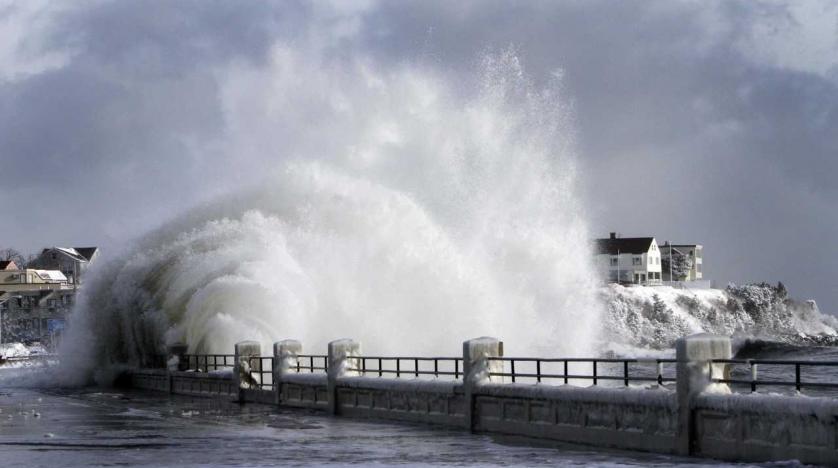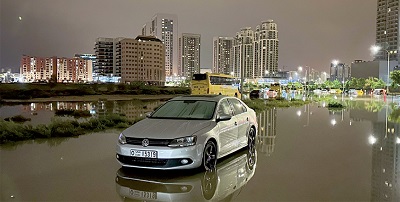‘Floating Cities’ to Face Climate Change Threats

Asharq Al-Awsat
London - New York
Oceanix is building a prototype floating island as an experimental solution for crowded coastal cities threatened by climate change, the company told the United Nations habitat program earlier this month.
Floating Cities
A group of architects, engineers and developers who met at the UN headquarters revealed that such buoyant islands would be linked together into floating, self-sustaining cities that rise with sea levels and are built to withstand hurricanes. Marc Collins Chen, an entrepreneur and former French Polynesian politician who founded Oceanix, said the prototype will be a small-scale version that could be ready within months.
The idea might sound outlandish, but urban coasts are running out of land and becoming increasingly vulnerable as sea levels are projected to rise as much as seven inches by 2030.
Ninety percent of the largest global cities are vulnerable to climate change, said Victor Kisob, UN habitat deputy director. To reclaim shrunken coastlines, Singapore and other seaside megacities already pour sand into the ocean, and sand is quickly becoming a scarce resource.
Bjarke Ingels of the Bjarke Ingels Group, the architectural firm partnering with Oceanix that is also redesigning the Mall's Smithsonian campus, said the full 4.5-acre floating platforms made of wood and bamboo would be "the basic molecule of a shared urban system."
Residential Platforms
Each platform would house 300 people. Markets, farms, low-rise apartments and solar panels would stack atop the platforms. The city would grow in a fractal pattern: Six linked platforms, like a hexagon of a honeycomb, would become a village. Six of those villages would be a 10,000-strong town covering 185 acres.
Oceanix's plans resemble communities that already exist: the houseboats that gather in Sausalito, California; floating apartment complexes in the Netherlands; generations of Tanka fishermen and women who live in China's southern waterways; the artificial reed islands in Peru's Lake Titicaca, home to the Uros tribe. Some of these coastal communities, like the Tanka's, are eroding as people venture on land to find work.
What makes an Oceanix city different, Collins Chen said, is its "integrated vision." The islands could power and feed themselves. Turbines in the air above the platforms and water below would provide energy, as would solar panels; rain and desalination systems would provide fresh water; greenhouses, aeroponic farms and aquatic gardens would provide food; moorings of Biorock, electrically charged structures that attract minerals and coral, would tether the platforms in place.
The first floating communities would be established at warm coasts, such as those in Southeast Asia.
Though architects claimed the platforms could withstand Category 5 hurricanes, ocean engineers suggested the initial cities should be built in calm bays, out of reach from cyclones and pounding waves.
Nicholas Makris, who directs the Center for Ocean Engineering at Massachusetts Institute of Technology, said: "You have to take small steps. If you're just trying to get something to work, do it in a sheltered, harbored area."
Weaving together energy consumption, food production, housing and the marine environment is also a huge challenge.
Latest News
 King, Bahrain monarch stress need to maintain Arab coordination
King, Bahrain monarch stress need to maintain Arab coordination Security Council to vote Thursday on Palestinian state UN membership
Security Council to vote Thursday on Palestinian state UN membership Dubai reels from floods chaos after record rains
Dubai reels from floods chaos after record rains Khasawneh, Saudi Shura Council speaker discuss bilateral ties, regional developments
Khasawneh, Saudi Shura Council speaker discuss bilateral ties, regional developments Egyptian Foreign Minister condemns potential Palestinian displacement as 'war crime'
Egyptian Foreign Minister condemns potential Palestinian displacement as 'war crime'
Most Read Articles
- King, Bahrain monarch stress need to maintain Arab coordination
- Dubai reels from floods chaos after record rains
- Security Council to vote Thursday on Palestinian state UN membership
- Khasawneh, Saudi Shura Council speaker discuss bilateral ties, regional developments
- Tesla asks shareholders to reapprove huge Musk pay deal
- Jordan will take down any projectiles threatening its people, sovereignty — Safadi
- Hizbollah says struck Israel base in retaliation for fighters' killing
- Princess Basma checks on patients receiving treatments
- Knights of Change launches nationwide blood donation campaign for Gaza
- The mystery of US interest rates - By The mystery of US interest rates, The Jordan Times